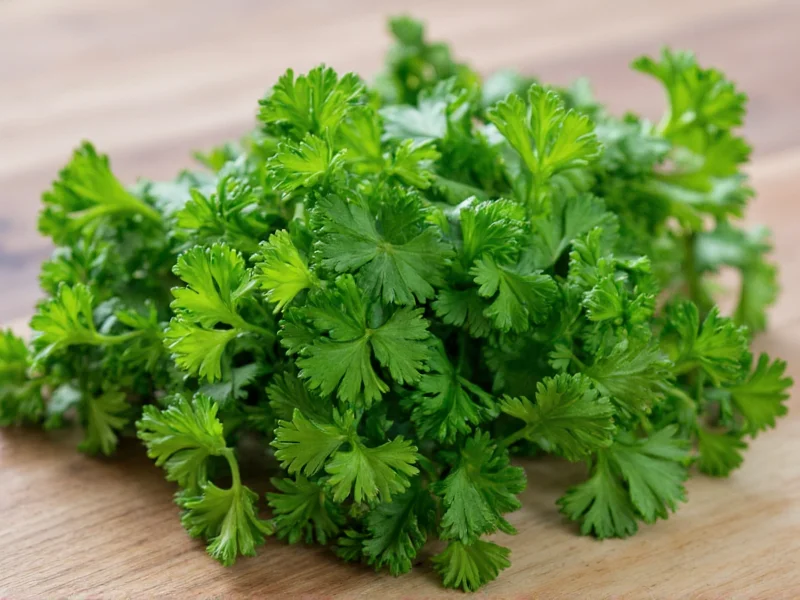Understanding herb conversions is essential for consistent cooking results. When substituting dried parsley for fresh (or vice versa), getting the ratio right prevents your dishes from becoming either bland or overpowering. This guide explains not just the numbers, but the culinary science behind herb conversions and when to adjust the standard ratio for best results.
Why the 1:3 Dried to Fresh Parsley Ratio Works
Fresh parsley contains approximately 85-90% water, while dried parsley has most of this moisture removed. This concentration effect means dried herbs deliver more flavor per volume. The 1:3 ratio accounts for this difference in density and potency.
However, this ratio isn't absolute. Several factors can influence the ideal conversion:
- Herb variety: Curly vs. flat-leaf parsley may have slightly different concentrations
- Drying method: Sun-dried vs. oven-dried vs. commercially dehydrated
- Storage time: Older dried herbs lose potency over time
- Recipe type: Long-simmering dishes vs. fresh garnishes
| Dried Parsley | Fresh Parsley Equivalent | Best Used In |
|---|---|---|
| ¼ teaspoon | ¾ teaspoon | Dressings, quick sauces |
| ½ teaspoon | 1½ teaspoons | Marinades, rubs |
| 1 teaspoon | 1 tablespoon | Stews, soups, long-cooking dishes |
| 1 tablespoon | 3 tablespoons (¼ cup) | Bulk recipes, canning |
When to Adjust the Standard Ratio
While 1:3 is the standard dried to fresh parsley conversion, smart cooks know when to tweak this ratio:
Use Less Dried Herb When:
- Making delicate dishes like fish or egg preparations
- Using premium dried herbs (often more potent)
- The recipe already contains other strong flavors
- You're adding dried herbs late in the cooking process
Use More Dried Herb When:
- Preparing hearty meat dishes or robust stews
- Using older dried herbs that have lost some potency
- The recipe will cook for several hours (flavor dissipates over time)
- You prefer stronger herb flavor in your cooking
Dried vs. Fresh Parsley: Culinary Applications
Understanding when to use each form of parsley matters as much as the conversion ratio:
Best Uses for Dried Parsley
Dried parsley works well in dishes with longer cooking times where fresh herbs would lose their flavor and texture. It's ideal for:
- Tomato-based sauces that simmer for hours
- Meatloaf and meatball mixtures
- Stocks and broths
- Dry rubs for meats
- Homemade seasoning blends
Best Uses for Fresh Parsley
Fresh parsley shines when its bright flavor and texture can be appreciated:
- As a finishing garnish
- In salads and fresh salsas
- In chimichurri and other herb sauces
- With fish and light poultry dishes
- In tabbouleh and other fresh grain salads
Common Mistakes in Parsley Substitution
Even with the correct ratio, these errors can ruin your dish:
- Adding dried herbs at the end: Dried herbs need time to rehydrate and release flavor. Add them early in cooking.
- Using the same ratio for all herbs: Different herbs have different water content. Rosemary is typically 1:4 while basil is closer to 1:2.
- Not adjusting for age: Dried herbs lose 20-30% of potency after 6 months. Older herbs may need a 1:2.5 ratio instead of 1:3.
- Measuring incorrectly: Always measure dried herbs by volume (teaspoons), not weight, for accurate conversion.
Maximizing Flavor: Storage Tips for Both Forms
Proper storage affects potency and thus your conversion accuracy:
Storing Fresh Parsley
Treat fresh parsley like flowers: trim the stems, place in water, cover loosely with a bag, and refrigerate. Properly stored, it lasts 1-2 weeks. For longer storage, chop and freeze in oil.
Storing Dried Parsley
Keep dried parsley in an airtight container away from light and heat. Properly stored, it maintains good flavor for 1-2 years, though peak potency is within 6 months of drying.
Advanced Technique: Creating Your Own Conversion Chart
For serious home cooks, creating a personalized conversion chart accounts for your specific herbs and preferences:
- Start with the standard 1:3 ratio
- Prepare two identical dishes, one with fresh, one with dried
- Adjust the dried version until flavors match
- Note your personal ratio for future reference
This method accounts for variables like your specific parsley variety, drying method, and personal taste preferences.











 浙公网安备
33010002000092号
浙公网安备
33010002000092号 浙B2-20120091-4
浙B2-20120091-4